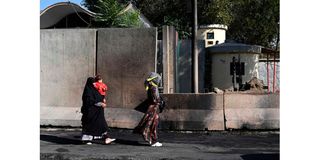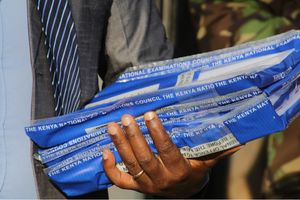I wore a black hijab to mourn my dreams

Women walk past the site of a blast at the Sardar Mohammad Dawood Khan military hospital in Kabul on November 3, 2021. For Maryam Nabavi, the day the Taliban arrived, her dreams and aspirations for a brighter future died.
What you need to know:
Like any other typical day in Kabul, Maryam Nabavi, an Afghan journalist went to her office on the morning of Sunday, August 15.
As soon as she checked her Facebook and Twitter accounts, she came across unconfirmed reports that the Taliban had reached parts of Kabul.
But the woman who returned home was no longer the one who had left that morning.
This story was produced in partnership with Rukhshana Media and is part of The Fuller Project’s ongoing series, Ending America’s forever war: What is next for Afghan women?, documenting what the end of America’s longest war on foreign soil means for the women who have lived through it.
It was Saturday, August 14, when I saw a friend who owns a store selling hijabs. Since the Taliban started seizing control of the country, he has been selling around 20 hijabs a day, and he asked me jokingly, “Won’t you buy one?” But I will never wear a hijab (full Islamic dress), and I replied to him, “I will never accept the Taliban’s demand that we do so.”
But I didn’t know that the next day, the world would turn upside down for many Afghan women.
Like any other typical day in Kabul, I went to my office on the morning of Sunday, August 15.
On the way, I noticed long queues of people in front of several banks, which was quite strange. I had never seen so many people lining up like that in front of banks in Kabul before.
The moment I entered our office, I was confronted with my colleague’s confused and anxious face. He started asking me for personal information, such as the details of my passport and those of my family. “The situation is worrying,” he said. “We need this information to be able to help you.”
Nearest ATM
As soon as I checked my Facebook and Twitter accounts, I came across unconfirmed reports that the Taliban had reached parts of Kabul. Like many rumours circulating on social media, I ignored them.
After speaking to a number of colleagues, we decided to go to the nearest ATM to get some cash. We were afraid that in this chaotic situation, our money would be stuck in the banks.
When we reached the ATM machines, there was a long queue. After waiting for a while, we were told that the machine was broken due to overuse.
We walked back to the office empty-handed. On the way, my two colleagues and I bought ice-cream, joking that we should “enjoy the last ice-cream before the Taliban arrive.” And then, one of my colleagues said, “We try to be happy even in the gloomiest moments.”
Suddenly, it felt as though people’s behaviour had changed. A 12-year-old boy pointed at me and my colleagues, and said to his friend, “These are their last days walking around the city, sightseeing”.
Another young man checking out my clothes warned me as he shouted, “When the Taliban come, they’ll come to you first!”
Security alarm
When we reached the office, our boss and other colleagues confirmed that all the banks were shut. We weren’t even finished talking when the security alarm turned on. We all rushed to the basement where the safe rooms were located.
We didn’t know what had happened. All we knew was that the situation was not good. We didn’t even know what we should do in such circumstances because we had not experienced a situation like that before. Among all the talk and rumours, one thing was clear: The Taliban had captured Kabul.
With my hands shaking and my throat dry, I called my family. “The Taliban are said to have taken parts of Dashte Barchi (West Kabul),” my husband said to me. Dashte Barchi is where we — and a number of my colleagues — live. It is one of the most deprived areas of Kabul, with more than one million Hazaras residing there.
“Let us go home,” I said, as I was getting overwhelmed with fear and anxiety.
After an hour of hiding in the basement, we were allowed to go home. Following the security instructions, we left the office in groups of three to five.
Full of traffic
With some colleagues, I went towards Dashte Barchi. All the streets of (central Kabul neighbourhood) Shahr-e-Naw were full of traffic. It was as if all of Kabul was conducting a raid.
In the 12 years of living in Kabul, I had never seen the city so chaotic. Of the hundreds of shops, only a handful were open. The streets were full of cars, but no one would take passengers. Even if they would, there was no way out of traffic. The cars seemed glued to each other; it would take hours for them to become untangled.
My colleagues and I started walking home. It felt like the entire city was doing what we were; fleeing. My clothes and my bag would get stuck with the cars. I almost fell over several times.
I could hardly breathe from thirst, but I didn’t dare stop at a shop and buy water. My legs were getting tired and heavy. I could not walk. It felt as though my shoulders couldn’t carry that amount of fear and despair.
On the way, I saw a woman running in a hurry she left one of her shoes behind. She didn’t even stop to get it. Getting to her destination as quickly as possible was more important to her than losing her shoe.
Ghost city
I did not exactly know how many kilometres we had walked, but we had walked for more than an hour. As we approached Kabul University, the situation seemed a bit more normal. We took a car to Dashte Barchi. When we arrived in Barchi, it seemed as if the entire population of one million people who lived in that small area had flown away. Barchi’s streets were totally silent.
Finally, after all the anxiety and fear, I reached home. I immediately grabbed my son and held him in my arms. I was happy to be alive and to be able to hold my baby.
Just some hours before, I was still a happy woman, leaving home for the office with so much hope. But the woman who returned home was no longer the one who had left that morning. Something had died in me, something like hope.
The day that the Taliban arrived, Kabul turned into a ghost city. A city in which all my dreams and aspirations for a brighter future died. I wore a black hijab to mourn my dreams.
Maryam Nabavi, 28, is an Afghan journalist




